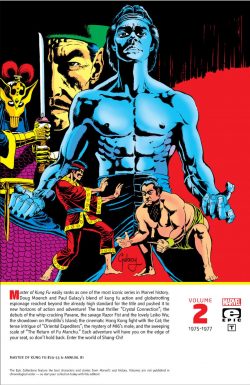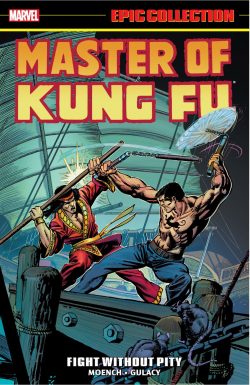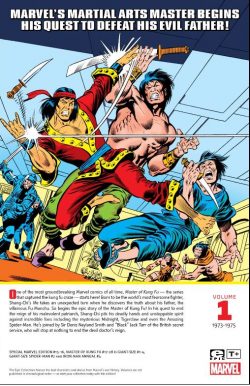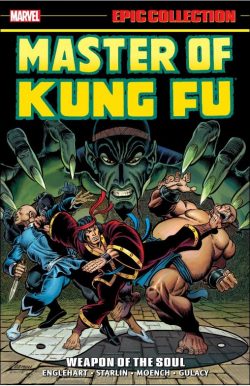

By Doug Moench, Paul Gulacy, Sal Buscema, Keith Pollard, Jim Craig & various (MARVEL)
ISBN: 978-1-3029-0135-6 (TPB/Digital edition)
Win’s Christmas Gift Recommendation: All-Out Action Blockbusterism… 9/10
Comic books have always operated within outworld popular trends and fashions – just look at what got published whenever westerns or science fiction dominated on TV – so when the ancient philosophy and discipline of Kung Fu made its mark on western entertainment, it wasn’t long before all those kicks and punches found their way onto four-colour pages of America’s periodicals. Early starter Charlton Comics added Yang and House of Yang to the pioneering Judo Joe and Frank McLaughlin’s Judomaster; DC debuted Richard Dragon and rebooted Karate Kid; Atlas/Seaboard opened (and as quickly closed again) The Hands of the Dragon and Marvel converted a developing proposed literary adaptation into an ongoing saga about a villain’s son.
A month after it launched, a second orient-inspired hero debuted with Iron Fist: combining combat philosophy, high fantasy and magical forces with a proper superhero mask and costume…
Although largely retrofitted for modern times, inspirational Master of Kung Fu star Shang-Chi originated with a lot of tricky baggage. He launched in the autumn of 1973, cashing in on a contemporary craze for Eastern philosophy and martial arts action that generated an avalanche of “Chop Sockey” movies and a controversial TV sensation entitled Kung Fu. You may recall that the lead in that western-set saga was a half-Chinese Shaolin monk, played – after much publicised legal and industry agitation – by a white actor…
At Marvel, no one at that time particularly griped about the fact that Shang-Chi was designed by editor Roy Thomas and artisans Steve Englehart, Jim Starlin & Al Milgrom as a naive innocent (also half Chinese, with an American mother) thrown into tumultuous modern society as a rebellious but involved counterpoint to his father: an insidious scheming fiend intent on global domination. Back then, securing rights to a major literary property and wrapping new comics in it was an established practise. It had worked spectacularly with Conan the Barbarian and horror stars like Dracula and Frankenstein. The same process also brilliantly informed seminal science fiction icon Killraven in War of the Worlds and plenty more…
These days we comics apologists keep saying “it was a different era”, but I genuinely don’t think anyone in the editorial office paused for a moment of second thoughts when their new Kung Fu book secured the use one of literature’s greatest villains as a major player. Special Marvel Edition #15 (cover-dated December 1973 so Happy 50th Anniversary) launched to great success, and an overarching villain already a global personification of infamy… Fu Manchu.
Arthur Henry Sarsfield Ward AKA Sax Rohmer’s ultimate embodiment of patronising mistrust and racist suspicion had been hugely popular since 1913’s The Mystery of Dr. Fu-Manchu. The prime archetype for mad scientists and the remorseless “Yellow Peril” threatening civilization, the character spread to stage, screen, airwaves and comics (even appropriating the cover of Detective Comics #1, heralding an interior series that ran until #28), but most importantly, became the visual affirmation and conceptual basis for countless evil “Asiatics”, “Orientals” and “Celestials” dominating popular fiction ever since.
In recent years we’ve all (well, mostly all) acknowledged past iniquities and Shang-Chi has been fully reimagined, with that paternal link downplayed and ultimately abandoned – as much for licensing laws as social justice. And cultural respect.
Like most comics companies, Marvel employed plenty of “Yellow Peril” knock-offs and personifications – including Wong Chu; Plan Tzu (AKA the Yellow – or latterly Golden – Claw); Huang Zhu; Silver Samurai; Doctor Sun, ad infinitum: all birds of another colour that are still nastily pejorative shades of saffron. Perhaps this is just my white guilt and fanboy shame talking. These stories, crafted by Marvel’s employees were – and remain – some of the best action comics you’ll ever encounter, but never forget what they’re actually about -distrust of the obviously other…
Without making excuses, I should also state that despite the casual racism suggested by legions of outrageously exotic, inscrutable lemon-hued bad guys haunting this series at every level, Master of Kung Fu did sensitively address issues of race and honestly attempt to share non-Christian philosophies and thought whilst, most importantly, offering potently powerful role models to kids of Asian origins. So at least there’s that …
Packed with stunning adventure and compellingly convincing drama, this second collection gathers Master of Kung Fu #29-53 and Master of Kung Fu Annual #1 (collectively spanning June 1975-August 1977). Written entirely by Doug Moench, surrendering to his love of spy fiction it opens without a preamble in the middle of a mighty struggle…
Previously: the series launched in bimonthly reprint title Special Marvel Edition as The Hands of Shang Chi: Master of Kung Fu and by the third issue (April 1974) became exclusively his. Origin episode ‘Shang-Chi, Master of Kung Fu!’ introduced a vibrant, brilliant young man raised in utter isolation in the style and manner of imperial China. Reared by monks and savants, the boy is the result of a match between a physically perfect American woman and “misunderstood patriot” Fu Manchu: a noble hero unfairly hunted and slandered by corrupt western governments and the communist usurpers now blasphemously controlling the world’s greatest empire.
His son was schooled to respect and obey his sire, trained to perfection in martial arts: designed as the ultimate warrior servant and the doctor’s devoted personal weapon against lifelong enemies Sir Dennis Nayland Smith and Doctor Petrie.
On reaching maturity, Shang – whose name means “the rising and advancing of a spirit” – was despatched to execute Petrie. However, after the obedient weapon completes his mission, he subsequently questions his entire life and the worldly benefit of killing an elderly, dying man. An emotional confrontation with Nayland Smith – who endured daily agonies from being maimed at the Devil Doctor’s command – further shakes the boy’s resolve and eventually Shang’s sublime education demands he reassess everything his father has taught him…
After invading the villain’s New York citadel and crushing his army of freaks and monsters, Shang Chi faces his father and rejects all he stands for. The battle lines of an epic family struggle were drawn…
Banished from his cloistered childhood home and environs, the philosophically minded innocent was forced to adapt rapidly to frenetic constant violence in the modern world and eventually accepted shelter with Nayland Smith in return for (espionage) services rendered…
A turning point in his rising and advancement came in MOKF #29 (cover-dated June 1975) as Shang finds a reason to abandon his pacifistic aspirations and become involved in western affairs after seeing firsthand the harm drugs cause. He joins Nayland Smith’s team – Petrie, Blackjack Tarr and Clive Reston (descendent of a famed “Consulting Detective” and a Double-0 operative “on Her Majesty’s Secret Service”) – to cripple the drug trade.
The entire series was slowly morphing into a James Bond pastiche and with this mission to end effetely urbane drug dealer/ covert nuclear terrorist Carlton Velcro, illustrator Paul Gulacy began a visual progression that would make him one of most watched and admired artists of the era as he referenced movie star and set pieces throughout the saga.
‘The Crystal Connection’ begins with Reston undercover at Velcro’s French coast fortress, playing heroin buyer Mr Blue until Shang and Tarr can infiltrate and secure the dope stocks . Nobody was expecting the massive defences, an army of killers led by deadly assassin Razor-Fist and a nuclear arsenal hidden below ‘A Gulf of Lions’ (#30, inked by Dan Adkins), with the pitched battle ranging far and wide as Razor Fist’s defeat led to Shang clashing with whip-wielding panther woman Pavane before a truly explosive conclusion in ‘Snowbuster’…
‘Assault on an Angry Sea!’ was a hasty fill-in illustrated by Sal Buscema & Mike Esposito as Shang returns to London by ship and is drawn into the hunt for an undercover courier who is unaware that counteragents intend to intercept and end them. A proper mystery yarn, Chi has many suspects and can’t tell friend from foe from target, but triumphs nonetheless…
MOKF #33 resumes the Moench/Gulacy filmic fun-fest as ‘Wicked Messenger of Madness’ introduces seductive, conflicted agent Leiko Wu as both romantic interest and wedge between Shang Chi and his colleagues, as a robotic mannequin fails to assassinate Nayland Smith thanks to martial arts mastery but opens the door to a complex web of lies, double-dealing, insane artificial intelligences and a doomsday weapon.
The robot was a tool of agent Simon Bretnor, revealed too late as narcissistic hired killer and would-be world conqueror Mordillo who wants a space weapon using the ozone layer and sunlight to ravage sites on Earth. The plans for it are encoded in Wu’s brain, but by the time she realises her current boyfriend Bretnor is the bad guy Leiko’s his prisoner on a manically murderous version of Fantasy Island…
As Shang and Resto race to the madly modified atoll-turned-playground-of-peril, Wu is attempting to reason with the crazed Mordillo, but gets more sense from his Pinocchio-like robot sidekick Brynocki who is trying to mediate the ‘Cyclone at the Center of a Madman’s Crown!’ She does, however, learn her captor had a connection to Pavane and Carleton Velcro and holds Chi responsible for a huge loss of face and fortune…
Another spectacular conclusion comes when manic and martial artist clash in the skies above the island as the villain briefly unleashes his stolen Solar Chute and rains destruction down on the island in ‘Death-Hand and the Sun of Mordillo’…
What feels like a reformatted leftover from the Giant-Size Master of Kung Fu era follows in #36 and 37 (January & February 1976, by Moench, Keith Pollard & Sal Trapani) as Shang enters a magical maze of mystery: seeking to defend a carnival of freaks voluntarily living in ‘Cages of Myth, Menagerie of Mirrors!’ from ninjas and their leader Darkstrider who weaves a ‘Web of Dark Death!’
Moench, Pollard, John Tartaglione & Duffy Vohland then continue the fantasy themes in Master of Kung Fu Annual #1 and a team-up with fellow transplanted warrior Iron Fist. Danny Rand and Shang are tricked into entering another dimension and invading ‘The Fortress of S’ahra Sharn!’ by trickster wizard Quan-St’ar, whose true goal is the destruction of immortal city K’un-Lun, but he made one big mistake…
At their creative peak Moench & Gulacy started an epic, ambitious, truly sophisticated and industry-changing run in MOKF #38 (March 1976). Here Shang Chi reluctantly accepts a rescue mission to extract an agent from Hong Kong, meeting lies, passion, disinformation and deadly love in ‘Cat’. Nayland Smith has again orchestrated events to satisfy his own agenda and saving Julia leads Chi into a ‘Fight Without Pity’ against an opponent who might well be his superior in combat ability and also holds the moral high ground…
The landmark clash is simply prologue to an extended, character driven serial that opens at ‘The Murder Agency’ (#40 with Gulacy inking himself) as the on-fire creators pioneer storytelling techniques later employed in Christopher Nolan’s Memento. A traitor in British Intelligence is murdering agents and the information Nayland Smith wanted from Julia should have given them vital advantage. However, as Shang again quits all “games of death and deceit” he, Tarr and Leiko are attacked by apparently Chinese agents masquerading as “Oriental Expediters”.
After helping to defeat the attackers, Wu leaves on a similar extraction mission and suggests that the embattled operatives re-enlist disgraced former agent and current drunken sot James Larner. When they try, he’s got a new pal also boozing himself to death… Reston…
That’s when another well-armed gang burst in guns blazing, laying down their lives simply to bait a trap the agents can’t afford to avoid…
With the spy saga solidly underway everything suddenly screeched to a halt as a deadline crunch necessitated another fill-in moment, with Moench, Sal Buscema & Esposito revealing a childhood moment in ‘Slain in Secrecy, and by Illusion!’ Here Shang recalls reluctant clashes with childhood companion M’nai – AKA Si Fan assassin Midnight – to prove Fu Manchu’s hallowed home harboured a thief and traitor…
Inked by Tom Sutton, the main event resumes in #42 with a welter of flashbacks, cross-cuts and flash forwards as ‘The Clock of Shattered Time’ introduces an electrically enhanced martial arts assassin who almost kills Chi. Shock-Wave has a strong but top-secret connection to Nayland Smith and nearly succeeds in blowing up the spy chief too…
As the MI5 mole and Shock-Wave set more bombs, MOKF #43 sees a changed and vengeful Shang Chi win a rematch with the amplified assassin in ‘A Flash of Purple Sparks’. As Leiko Wu escorted her own living package across Europe with the Oriental Expediters chasing them all the way to an MI5 safehouse in Switzerland, Shang was waiting, but his triumph was short-lived as Leiko’s charge revealed who was behind all the deaths and the Oriental Expediter organisation, and that in London another of his allies had fallen…
The drama kicked into overdrive with a long-anticipated event. Cover-dated September 1976, #44 heralded ‘The Return of Fu Manchu, Prelude: “Golden Daggers (A Death Run)”’ as the scattered British agents head for home under a hail of gunfire and assorted ambushes. At last revealed is how the Devil Doctor’s recalcitrant first-born Fah Lo Suee is at war with their father for control of his empire.
She originally debuted in third novel The Si-Fan Mysteries / The Hand of Fu-Manchu in 1917 (or fourth outing The Daughter of Fu-Manchu in 1931, depending on who you ask) and was a minor character here since Master of Kung Fu #26, but here steps into the spotlight after Nayland Smith is finally downed by his most trusted ally…
On the back foot and losing, Fah Lo Suee seeks alliances and her brother’s aid in ‘Part One (Shang Chi): “The Death Seed!”’ while Fu Manchu is occupied with resurrecting his founding ancestor to be his new – loyal – son/enforcer. In London, Larner saves Nayland Smith even as Reston, Shang and Wu reunite and rebuff the “daughter of the Devil” – and that’s when Clive makes a big mistake and is taken by Fah Lo Suee…
Inked by Pablo Marcos, ‘Part Two (Clive Reston): “The Spider Spell!”’ divides attention between the British agent’s trial and eventual triumph and Fu resurrecting legendary warlord Shaka Kharn, whilst ‘Part Three (Leiko Wu): “Phantom Sand”’ details how she and Shang infiltrate a fantastic city at the north pole in advance of what’s left of the team joining them to destroy the citadel. Before that, though, the final clash between father and daughter again confirms the total mastery of the malevolent mandarin…
The true appalling scope of the Devil Doctor’s ambitions are exposed in ‘Part Four (Black Jack Tarr): “City in the Top of the World”’ as the schemer prepares to leave Earth and cull its population by 90% as Shang duels resurrected revenant Shaka Kharn, and battles his way aboard his sire’s space shuttle even as his companions destroy the base at the cost of another valiant soul in ‘Part Five (Sir Dennis Nayland Smith): “The Affair of the Agent Who Died!”’
The astounding saga – and Gulacy’s interior involvement – ends with #50 with the villain speaking for himself as his plans and perhaps his over-extended life are ended in ‘Part Six (Fu Manchu): “The Dreamslayer!”’
Master of Kung Fu #51 saw Jim Craig join Moench & Marcos, taking over the art for ‘Epilogue: “Brass and Blackness!” (A Death Move!!)’ infilling details of interments and getting back to Earth where the unhappy warrior again quit the spy world…
The final tale here (#52, May 1977) is one more fill-in as Moench & Pollard reintroduce Groucho Marx tribute Rufus T. Hackstabber who invites our baffled battler to ‘A Night at the 1001 Nights!’ in search of family (such as reprobate/WC Fields analogue Quigley J. Warmflash), riches and safety from mercenaries led by Si-Fan general Tiger-Claw…
Ernie Chan’s cover to MOKF #53 (which reprinted #20) leads into an extras section including Gil Kane & Adkins’ covers to Savage Fists of Kung Fu tabloid collectors edition, house ads and 10 pages of original art, unused and modified covers. The published ones throughout were crafted by Kane, Adkins, Sal Buscema, Rich Buckler, Dave Cockrum, Marie Severin, Chan, Gulacy, John Romita Jr., Ron Wilson & Jack Abel, Al Milgrom, Esposito, Joe Sinnott, Frank Giacoia and Klaus Janson.
In recent years, Shang Chi’s backstory has been adapted and altered. His father was understandably reinvented as Zheng Zu, Mr. Han, Chang Hu, Wang Yu-Seng and The Devil Doctor so depending on your attitude, you have the ultimate choice and sanction of not buying or reading this material. If you do – with eyes wide open and fully acknowledging that the past is another place that we can now consign to history – your comics appreciation faculties will see some amazing stories incredibly well illustrated: ranking amongst the most exciting and enjoyable in Marvel’s canon.
© 2018 MARVEL.


